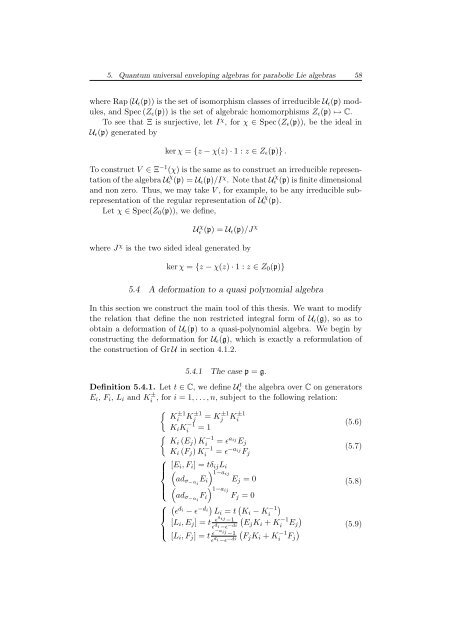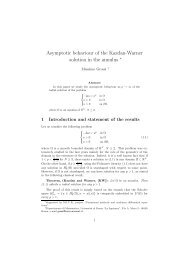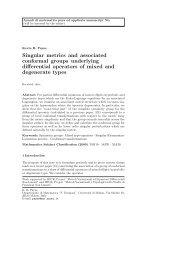Degree of Parabolic Quantum Groups - Dipartimento di Matematica ...
Degree of Parabolic Quantum Groups - Dipartimento di Matematica ...
Degree of Parabolic Quantum Groups - Dipartimento di Matematica ...
You also want an ePaper? Increase the reach of your titles
YUMPU automatically turns print PDFs into web optimized ePapers that Google loves.
5. <strong>Quantum</strong> universal enveloping algebras for parabolic Lie algebras 58<br />
where Rap(Uǫ(p)) is the set <strong>of</strong> isomorphism classes <strong>of</strong> irreducible Uǫ(p) modules,<br />
and Spec (Zǫ(p)) is the set <strong>of</strong> algebraic homomorphisms Zǫ(p) ↦→ C.<br />
To see that Ξ is surjective, let I χ , for χ ∈ Spec (Zǫ(p)), be the ideal in<br />
Uǫ(p) generated by<br />
ker χ = {z − χ(z) · 1 : z ∈ Zǫ(p)} .<br />
To construct V ∈ Ξ −1 (χ) is the same as to construct an irreducible representation<br />
<strong>of</strong> the algebra U χ ǫ (p) = Uǫ(p)/I χ . Note that U χ ǫ (p) is finite <strong>di</strong>mensional<br />
and non zero. Thus, we may take V , for example, to be any irreducible subrepresentation<br />
<strong>of</strong> the regular representation <strong>of</strong> U χ ǫ (p).<br />
Let χ ∈ Spec(Z0(p)), we define,<br />
U χ ǫ (p) = Uǫ(p)/J χ<br />
where J χ is the two sided ideal generated by<br />
kerχ = {z − χ(z) · 1 : z ∈ Z0(p)}<br />
5.4 A deformation to a quasi polynomial algebra<br />
In this section we construct the main tool <strong>of</strong> this thesis. We want to mo<strong>di</strong>fy<br />
the relation that define the non restricted integral form <strong>of</strong> Uǫ(g), so as to<br />
obtain a deformation <strong>of</strong> Uǫ(p) to a quasi-polynomial algebra. We begin by<br />
constructing the deformation for Uǫ(g), which is exactly a reformulation <strong>of</strong><br />
the construction <strong>of</strong> Gr U in section 4.1.2.<br />
5.4.1 The case p = g.<br />
Definition 5.4.1. Let t ∈ C, we define Ut ǫ the algebra over C on generators<br />
Ei, Fi, Li and K ± i , for i = 1, . . .,n, subject to the following relation:<br />
K ±1<br />
i K±1<br />
j<br />
KiK −1<br />
= 1<br />
i<br />
= K±1<br />
j K±1<br />
i<br />
Ki (Ej) K −1<br />
i = ǫaij Ej<br />
Ki (Fj)K −1<br />
i = ǫ−aij Fj<br />
⎧<br />
[Ei, Fi] = tδijLi<br />
⎪⎨ 1−aij adσ−α Ei Ej = 0<br />
i<br />
⎪⎩<br />
1−aij adσ−α Fi Fj = 0<br />
i<br />
⎧ <br />
<strong>di</strong> −<strong>di</strong> ⎪⎨<br />
ǫ − ǫ Li = t<br />
⎪⎩<br />
Ki − K −1<br />
i<br />
[Li, Ej] = t ǫaij −1<br />
ǫ<strong>di</strong>−ǫ−<strong>di</strong> [Li, Fj] = t ǫ−aij −1<br />
ǫ<strong>di</strong>−ǫ−<strong>di</strong> <br />
EjKi + K −1<br />
i Ej<br />
<br />
FjKi + K −1<br />
i Fj<br />
<br />
<br />
(5.6)<br />
(5.7)<br />
(5.8)<br />
(5.9)








